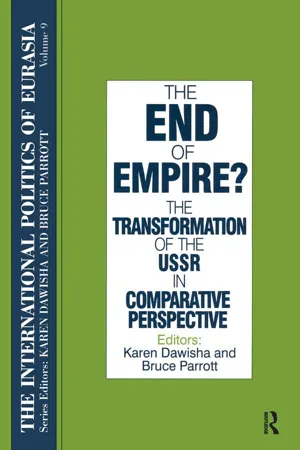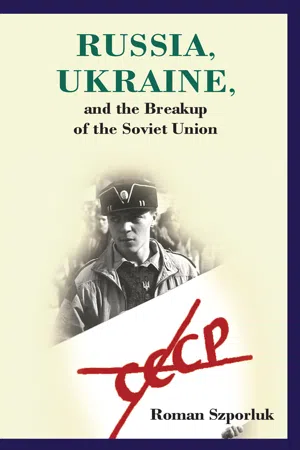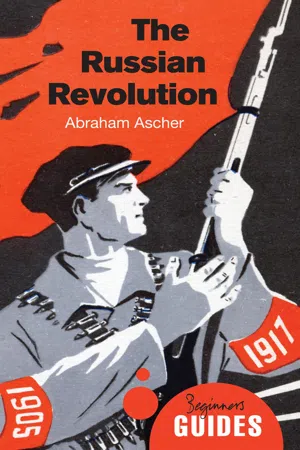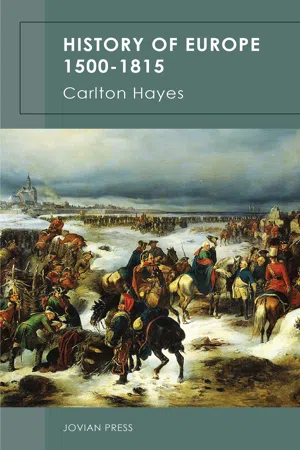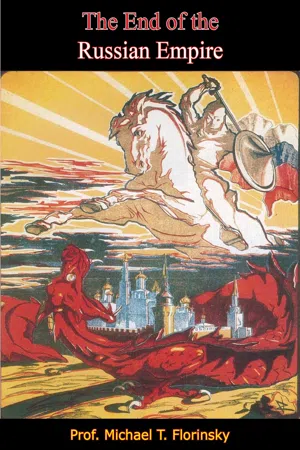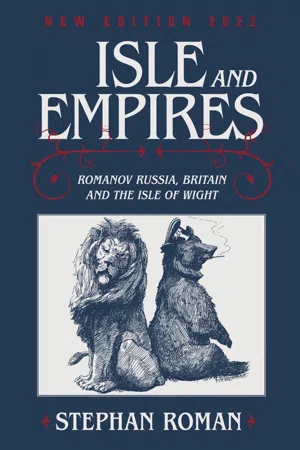History
Fall of Russian Empire
The fall of the Russian Empire refers to the collapse of the Romanov dynasty and the subsequent establishment of the Soviet Union in 1917. This event was marked by widespread social unrest, economic turmoil, and the Bolshevik Revolution, which ultimately led to the end of the centuries-old imperial rule in Russia.
Written by Perlego with AI-assistance
Related key terms
6 Key excerpts on "Fall of Russian Empire"
- S. Frederick Starr, Karen Dawisha(Authors)
- 2016(Publication Date)
- Routledge(Publisher)
II Imperial Disintegration
The Russian Question and Imperial Overextension Roman Szporluk3 The Fall of the Tsarist Empire and the USSRIntroduction
The Russian state collapsed twice in the twentieth century. In 1917, the Russian Empire disintegrated while it was fighting and losing a foreign war. The Soviet Union broke apart in 1991, in peacetime, several decades after it had won the greatest war in Russia’s long history of wars. The first state collapsed before the Communists took power; the second, when it was under Communist rule.Many works have been written—and even more will be written—about causes of the breakup of both the Russian Empire and the USSR.1 Our task here is much more modest—to focus on certain distinct “factors” (“circumstances,” “conditions”) which substantially contributed to these events, without claiming, however, that these are sufficient or necessary “causes” of what happened.Unlike empires of modern times that fell while their former metropoles were gradually being transformed into “normal” nations and nation-states, the tsarist—and then the Soviet—empire fell apart before a modern Russian nation and a Russian nation-state had emerged. A major factor in the imperial collapse in 1917, and in the Soviet collapse in 1991, proved to be conflict between the imperial state and an emergent Russian nation or “society.” In both cases, “Russia” contributed to the fall of “Empire.” This leads us to the conclusion that both empires failed to solve the “Russian Question”—arguably their most important nationality question.Another major factor in the fall of both the Russian and Soviet empires was their overextension. They established their hegemony over nations and territories that refused to recognize Russia and /or the USSR as a superior civilization, a higher form of economy and government—qualities which an empire must possess if its rule is not to be based on coercion alone. To maintain hegemony over them in the absence of such recognition required a disproportionate reliance on coercion, and this made Russian rule in “Europe” a heavy burden on the Russian people, which in turn further contributed to the alienation of the Russians from “their” state. These were additional obstacles to the formation of a modern Russian nation. Thus, the inclusion of non-Russian peoples under Imperial/Soviet rule negatively affected the conditions under which the Russians lived. Having been called—and coerced—by their rulers, both tsarist and Communist, to serve “the great cause” of the empire, the Russians found it very difficult to establish for themselves a political identity distinct from and independent of empire.- Roman Szporluk(Author)
- 2020(Publication Date)
- Hoover Institution Press(Publisher)
16 The Fall of the Tsarist Empire and the USSR: The Russian Question and Imperial OverextensionIntroduction
The Russian state collapsed twice in the twentieth century. In 1917, the Russian Empire disintegrated while it was fighting and losing a foreign war. The Soviet Union broke apart in 1991, in peacetime, several decades after it had won the greatest war in Russia’s long history of wars. The first state collapsed before the Communists took power; the second, when it was under communist rule.Many works have been written—and even more will be written—about causes of the breakup of both the Russian Empire and the USSR.1 Our task here is much more modest—to focus on certain distinct “factors” (“circumstances,” “conditions”) which substantially contributed to these events, without claiming, however, that these are sufficient or necessary “causes” of what happened.Unlike empires of modern times that fell while their former metropoles were gradually being transformed into “normal” nations and nation-states, the tsarist—and then the Soviet—empire fell apart before a modern Russian nation and a Russian nation-state had emerged. A major factor in the imperial collapse in 1917, and in the Soviet collapse in 1991, proved to be conflict between the imperial state and an emergent Russian nation or “society.” In both cases, “Russia” contributed to the fall of “empire.” This leads us to the conclusion that both empires failed to solve the “Russian Question”—arguably their most important nationality question.Another major factor in the fall of both the Russian and Soviet empires was their overextension. They established their hegemony over nations and territories that refused to recognize Russia and/or the USSR as a superior civilization, a higher form of economy and government—qualities an empire must possess if its rule is not to be based on coercion alone. To maintain hegemony over them in the absence of such recognition required a disproportionate reliance on coercion, and this made Russian rule in “Europe” a heavy burden on the Russian people, which in turn further contributed to the alienation of the Russians from “their” state. These were additional obstacles to the formation of a modern Russian nation. Thus, the inclusion of non-Russian peoples under Imperial/Soviet rule negatively affected the conditions under which the Russians lived. Having been called—and coerced—by their rulers, both tsarist and communist, to serve “the great cause” of the empire, the Russians found it very difficult to establish for themselves a political identity distinct from and independent of empire.- eBook - ePub
The Russian Revolution
A Beginner's Guide
- Abraham Ascher(Author)
- 2014(Publication Date)
- Oneworld Publications(Publisher)
3 The collapse of tsarismFor about a decade after the dissolution of the Second Duma, the Russian leadership did not face a mass movement bent on overturning the tsarist regime, but the political waters were not entirely calm. Unrest in the countryside surfaced periodically, and strikes by workers in various industrial regions were not uncommon. The most dramatic broke out in 1912 in the Lena Goldfields in Siberia, which the army crushed with terrifying brutality, killing some two hundred workers. Far from ending worker unrest, this cruelty spurred workers in other parts of the country to stage strikes during which they voiced economic as well as political demands. In July 1914, a strike movement that often involved violence engulfed various regions. At no time until 1917 did the authorities face the kind of danger to the stability of the state that they had confronted in 1905.World War I
Once again, the decisive factor in turning deep discontent into revolutionary action was a military conflict that exposed Russia’s weakness and recklessness, and caused untold suffering to millions of ordinary citizens. One of the curious aspects of World War I is that no responsible leader wanted to lead his country into battle; if in 1914 the monarchs and ministers had had any inkling of the consequences of the war, they probably would not have given their armies the order to march. When the fighting ended four years later, millions of people had perished, three monarchs had lost their thrones, national boundaries had been changed, often arbitrarily, revolutions had erupted in several countries, and the ensuing bitterness throughout Europe had set the stage for yet another world war even more costly in every respect than the first one.Ideology, as much as anything else, dictated the policy of Russian statesmen and of Tsar Nicholas II during the international crisis that erupted on 15 June (commonly noted as 28 June in the Gregorian calendar) 1914. On that day, the Archduke Franz Ferdinand, heir to the Habsburg throne, was assassinated, together with his wife, in Sarajevo, the capital of Bosnia, a province populated by Slavs that Austria-Hungary had annexed in 1908. The government in Vienna concluded that the assassination was part of a plan by Serbia to gain control over Bosnia and to establish a new state, Yugoslavia, which was to embrace all southern Slavs. The Austro-Hungarian statesmen feared such a development, because it would most likely lead to the unraveling of their multinational state. They therefore decided on a provocative and aggressive step. They sent an ultimatum to Serbia demanding not only the suppression of all anti-Austrian agitation but also the participation of Austrians in the crackdown. No sovereign government could accept such conditions, and Serbia was no exception. On 15 July (commonly noted as 28 July in the Gregorian calendar), Austria-Hungary declared war on Serbia. - eBook - ePub
- Carlton Hayes(Author)
- 2017(Publication Date)
- Jovian Press(Publisher)
THE RISE OF RUSSIA AND THE DECLINE OF TURKEY, SWEDEN, AND POLAND
.................. RUSSIA IN THE SEVENTEENTH CENTURYHow the backward, Oriental tsardom of Muscovy has been transformed into the huge empire of Russia, now comprising one-sixth of the land surface and one-twelfth of the population of the earth, is one of the most fascinating phases of the history of modern times. It was not until the eighteenth century that Russia came into close contact with the commerce and culture of western Christendom; not until then did she become a great power in the European family of nations.Several occurrences during the two centuries which separated the reign of the Tsar Ivan the Great from that of Peter the Great paved the way for the subsequent, almost startling rise of the powerful empire of northern and eastern Europe. The first in importance was the expansion of the Russian race and dominion. Throughout the sixteenth and seventeenth centuries the farming folk of the region about Moscow were emigrating south and east and establishing themselves in the fertile plains of the Don, the Volga, and the Irtysh. [Armies of the tsar backed up the colonists: they occupied Kazan in 1552 and Astrakhan, near the Caspian Sea, in 1554.] A glance at the map of Russia will show how the network of rivers combined with the level character of the country to facilitate this process of racial expansion. The gentle southerly flowing Dnieper, Don, and Volga, radiating from the same central region, and connected by way of the Kama with the headwaters of the Dwina, which empties into the White Sea in the extreme north, became chief channels of trade and migration, and contributed much more to the elaboration of national unity than any political institutions. Boats could be conveyed over flat and easy portages from one river-basin to another, and these portages with a relatively small amount of labor were gradually changed into navigable channels, so that even now the canals are more important than many of the railways as arteries of commerce. - eBook - ePub
- Prof. Michael T. Florinsky(Author)
- 2017(Publication Date)
- Borodino Books(Publisher)
The next stage was reached in February-March, 1917, when the long rule of the Tsars was brought to an end and the forces of discontent and social hatred, so long suppressed, were suddenly set free. The result of this new process was the establishment of a régime adhering to principles such as those proclaimed by Lenin. With complete contempt for the rather flattering theory of a sinister and powerful Soviet conspiracy, Trotsky frankly admits that “it was impossible to tell in advance whether we were to stay in power or be overthrown.” And he also confesses that the work of the Soviet Government in the first months was nothing else but “an immense legislative improvisation,” an exposition of the party program “in the language of power” rather than a constructive policy of political and social reforms {604} But it flattered the masses, encouraged them to follow a line of conduct on which they had already set their mind; and it was only a government supporting such a policy that could maintain itself in the midst of the revolutionary upheaval. Under the conditions which prevailed in Russia in the second half of 1917, it would seem hardly correct to picture the Bolsheviks as mere usurpers.” {605} Conclusion If we look back on the period of Russia’s history covered by this volume and attempt to appraise the forces which brought about the fall of the Tsars and paved the way for Bolshevism, all Russia in 1914-1917 will appear as an uneasy sea gradually lashed to fury by the winds of the approaching revolutionary storm. The source of the catastrophe which overcame the Empire may, undoubtedly, be traced far back in the history of the Russian people. As long as the country was not asked to make the supreme and heroic effort imposed upon it by the War, it managed to trail, and not without a certain degree of success, behind the other European countries along the road of economic development and progress. But the Great War put the whole framework of the Empire to a severe test - eBook - ePub
Isle and Empires
Romanov Russia, Britain and the Isle of Wight
- Stephan Roman(Author)
- 2021(Publication Date)
- Medina Publishing(Publisher)
It is tempting, when looking back on the final years of Tsarist Russia, to speculate that a revolution was not in fact inevitable. In many ways, it seems that the country was heading in the right direction. There was growing economic prosperity, greater political and personal freedom, a flourishing artistic and cultural scene. Many have blamed the First World War for the destruction of Imperial Russia. They argue that if it had not been for the violent shock and stress that this imposed on the country, the Tsarist regime would have survived and perhaps evolved into a liberal constitutional monarchy.Over a hundred years after the events of 1917-18, it is hard to know in which direction Russia might have developed without the First World War. In 1913, when the Romanov dynasty celebrated 300 years on the throne of Russia, it looked possible that the regime would survive well into the twentieth century. The reality, though, was much less positive, and many people in government and amongst the ruling elite were growing increasingly concerned about the way the Tsar and his government were running the country. Amongst a wider section of the population, there was growing frustration with the Tsar’s limited commitment to democratic reform, and a sense that he was not serious in wanting to create a more liberal society.Economic growth was unevenly spread, and large parts of the population felt that they were not benefiting from the growing prosperity in the country. There was widespread discontent in the rural areas and huge poverty amongst the industrial workers in the cities. Revolutionary movements may have been less visible, but many students, intellectuals, peasants and workers still felt the attraction of violent political agendas. This was a country which was not at peace with itself, and where social and class resentments may have been muffled, but were still very present. The Romanov dynasty was sitting on a volcano that was ready to erupt.Pyotr Stolypin had been appointed Prime Minister of Russia in July 1906. He was one of the Tsar’s most capable Ministers and understood very clearly the challenges that were facing the country. On taking power he immediately dissolved the First Duma, because of its radical nature and stubborn refusal to work with him and his government. When some of the more radical members fled into exile in the Finnish town of Vyborg and issued a manifesto calling for public resistance and tax evasion, he decided to allow the authors of the manifesto to return to Russia without any retribution.
Index pages curate the most relevant extracts from our library of academic textbooks. They’ve been created using an in-house natural language model (NLM), each adding context and meaning to key research topics.
